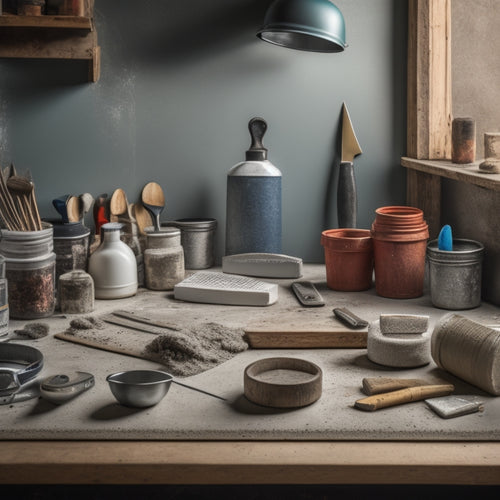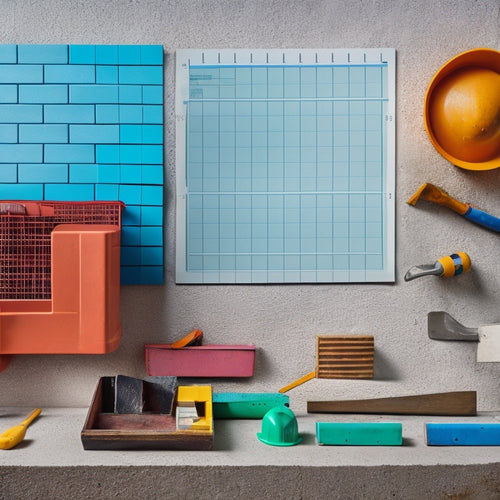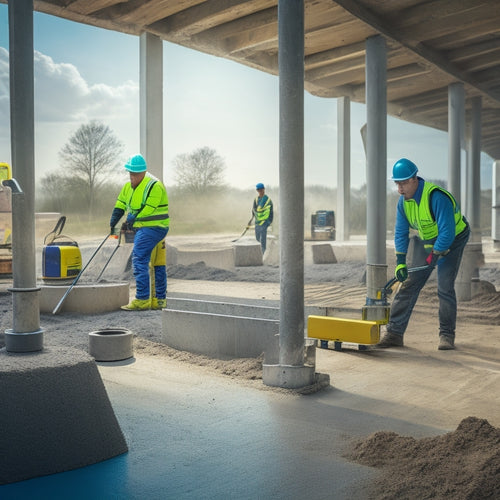
Top Tools for Concrete Floor Prep Success
Share
When it comes to concrete floor prep success, you need the right tools for the job. From removing old adhesives and coatings to grinding and polishing the surface, every step requires specialized equipment. To prepare the floor, you'll need tools like scrapers, grinders, and solvents to remove old coatings, as well as degreasers and pressure washers to clean and degrease the surface. Profiling tools like shot blasters and scarifiers help create the right texture, while trowels and edging tools are essential for smoothing and finishing the floor. With the right tools and techniques, you'll be well on your way to a successful flooring project - and there's much more to explore to guarantee a flawless finish.
Key Takeaways
• Diamond grinders are ideal for aggressive grinding and uneven surface removal in concrete floor preparation.
• Edge grinders are effective for tight spaces, corners, and edges, ensuring a smooth finish.
• Trowels, including float, power, and hand trowels, are essential for removing excess material and smoothing the surface.
• Dustless grinders are suitable for confined areas or sensitive equipment use, minimizing dust and debris.
• Profiling tools, such as shot blasters, grinders, or scarifiers, enhance mechanical bond by removing laitance, dirt, and contaminants.
Removing Old Adhesive and Coatings
Before applying a new floor coating, you'll need to thoroughly remove old adhesive and coatings to guarantee a strong bond between the concrete and the new material. This step is vital, as any remaining residue can compromise the integrity of the new coating.
You'll want to choose the right adhesive removal techniques for the type of coating you're dealing with. For example, solvent-based adhesives may require a chemical stripper, while water-based adhesives can be removed with a scraper or grinding tool.
When it comes to coating types, epoxy, polyurethane, and acrylic coatings each have their own unique removal requirements. It's important to identify the type of coating you're working with to select the most effective removal method.
Additionally, you may need to use a combination of techniques, such as scraping, grinding, and solvent application, to guarantee complete removal. By taking the time to properly remove old adhesive and coatings, you'll set yourself up for success with your new flooring project.
Grinding and Polishing the Surface
With the old adhesive and coatings completely removed, you'll need to grind and polish the concrete surface to create a smooth, even finish that's ready for the new coating. This critical step in surface preparation techniques requires the right polishing equipment options to achieve ideal results.
| Polishing Equipment Options | Description |
|---|---|
| Diamond Grinders | Use for aggressive grinding and removing uneven surfaces |
| Polishing Pads | Employ for honing and polishing to achieve a high-gloss finish |
| Edge Grinders | Utilize for grinding and polishing edges, corners, and tight spaces |
| Concrete Sanders | Implement for fine-tuning and smoothing out the surface |
| Dustless Grinders | Opt for when working in confined spaces or with sensitive equipment |
When selecting polishing equipment, consider the surface condition, desired finish, and personal comfort level. Remember to always follow the manufacturer's guidelines and safety protocols to guarantee a successful outcome. By mastering the art of grinding and polishing, you'll be able to achieve a flawless finish that's ready for the new coating, ultimately leading to a longer-lasting and more durable concrete floor.
Filling Joints and Cracks Effectively
You'll need to fill joints and cracks to prevent the new coating from seeping into these gaps and causing failures, guaranteeing a strong, uniform bond between the concrete and the new surface. This vital step is often overlooked, but it's essential for a successful concrete floor prep.
When filling joints, you'll want to use a joint sealant specifically designed for concrete. These sealants are flexible and can withstand the natural movement of the concrete, guaranteeing a long-lasting seal. Apply the sealant according to the manufacturer's instructions, making sure to fill the joint completely.
For cracks, you'll need a crack filler that's compatible with your chosen coating. These fillers come in various forms, including epoxies, polyurethanes, and acrylics. Choose a filler that matches the width and depth of the crack, and apply it according to the manufacturer's instructions.
Make sure the filler is fully cured before applying the new coating. By filling joints and cracks effectively, you'll guarantee a strong, durable bond between the concrete and the new surface, resulting in a long-lasting and high-quality finish.
Profiling the Concrete Floor
Frequently, profiling the concrete floor is a crucial step in concrete floor prep, as it helps to achieve a strong mechanical bond between the concrete and the new surface by removing laitance, dirt, and other contaminants.
You'll need to choose the right concrete profiling techniques for your project, considering factors like the floor's condition, desired surface texture, and the type of coating or topping to be applied. A thorough surface texture analysis will help you determine the best profiling method.
You may need to use a combination of techniques, such as shot blasting, grinding, or scarifying, to achieve the desired surface profile. When profiling, you're aiming to create a surface with the right amount of texture, typically a CSP (Concrete Surface Profile) rating of 2-4.
This guarantees a strong bond between the old concrete and the new surface, while also allowing for proper drainage and reducing the risk of delamination.
Cleaning and Degreasing the Floor
When you're preparing a concrete floor for a new coating or finish, you'll need to thoroughly clean and degrease the surface to guarantee a strong bond.
You'll want to start by removing any old coatings, adhesives, or sealers that may be present, as these can interfere with the new application.
Next, you'll need to employ effective degreasing methods to eliminate any oils, greases, or other contaminants that could compromise the integrity of the new finish.
Remove Old Coatings
Removing old coatings, sealers, and adhesives is a vital step in preparing your concrete floor for a new finish, as these substances can interfere with the bonding of new materials.
You'll need to make certain that all residual coatings are completely removed to achieve a strong bond between the old concrete and the new finish. This process is known as coating removal, a significant aspect of surface preparation.
To accomplish this, you'll need to assess the type of coating or adhesive present on the floor. Different coatings require specific removal techniques, so it's important to identify the coating type before proceeding.
You may need to use mechanical or chemical methods to break down and remove the coating. Mechanical methods involve using tools like scrapers, grinders, or sanders to physically remove the coating. Chemical methods, on the other hand, involve applying a solvent or stripper to dissolve the coating.
Regardless of the method, thorough removal is vital to guarantee a successful surface preparation. By effectively removing old coatings, you'll create a clean, prepared surface that's ready for the new finish.
Effective Degreasing Methods
You'll need to degrease your concrete floor to remove dirt, grime, and oils that can compromise the bond between the old concrete and the new finish. This critical step requires a thorough understanding of effective degreasing methods.
To achieve a successful bond, you must remove all contaminants that can interfere with the adhesion process. Start by sweeping or blowing the floor to remove any debris, followed by a thorough cleaning with a biodegradable degreaser. These eco-friendly products are specifically designed to break down and emulsify oils, making them easier to remove.
Next, use pressure washing techniques to rinse the floor. Ensure you use a wide fan tip and keep the nozzle at least 12 inches away from the surface to avoid damaging the concrete. A pressure washer with a minimum of 3,000 psi is recommended for effective degreasing.
After rinsing, use a clean water rinse to remove any remaining residue. By following these steps, you'll be able to achieve a clean, oil-free surface that's ready for the next stage of concrete floor prep.
Applying Concrete Floor Primers
Before applying a concrete floor primer, verify the substrate is clean, dry, and free of any contaminants or old coatings that might interfere with the primer's bonding process.
This vital step guarantees a strong bond between the primer and the concrete, which is essential for a successful floor prep. Surface preparation importance can't be overstated, as it directly impacts the primer's performance.
When applying the primer, use the right primer application techniques to achieve the best results.
Start by reading the manufacturer's instructions and following the recommended application rate. Typically, primers are applied in thin, even coats using a lambswool applicator or a microfiber mop.
Work in sections, dividing the floor into smaller areas to maintain even coverage. Avoid puddling or over-saturating the surface, as this can lead to uneven drying and adhesion issues.
Allow the primer to dry according to the manufacturer's instructions before proceeding with the next step in your concrete floor prep process. By following these guidelines, you'll guarantee a strong, durable bond that will withstand the demands of your finished floor.
Smoothening the Floor With Trowels
When you're smoothening a concrete floor, you'll need to choose the right trowel for the job - one that's suited to the type of finish you're aiming for.
You'll want to take into account factors like the trowel's material, size, and edge shape to guarantee you achieve a smooth, even finish.
Trowel Selection Matters
Your trowel selection plays a critical role in achieving a smooth, even finish, as the right tool can make all the difference in efficiently spreading and leveling concrete. With so many trowel types and techniques available, it's crucial to choose the right one for your specific project.
Here are four key considerations to keep in mind when selecting a trowel:
-
Trowel size: Choose a trowel that's large enough to cover a significant area, but small enough to maneuver in tight spaces.
-
Trowel material: Select a trowel made from durable, high-quality materials that can withstand the rigors of concrete work.
-
Trowel edge: Opt for a trowel with a straight or curved edge, depending on the type of finish you're trying to achieve.
- Handle type: Consider a trowel with a comfortable, ergonomic handle that reduces fatigue and improves control.
Achieving Smooth Finish
Achieving Smooth Finish
With your trowel selection in hand, you can now focus on achieving a smooth finish by using the right techniques to smoothen the floor. To get started, make sure the concrete surface is clean, dry, and free of any debris or oil. Next, apply a surface treatment, such as a bonding agent or a self-leveling compound, to create a strong bond between the old and new concrete.
Smoothing Techniques Comparison
| Technique | Description |
|---|---|
| Float and Trowel | Uses a float to remove excess material, followed by a trowel to smooth the surface. Ideal for large areas. |
| Power Trowel | Utilizes a powered trowel to rapidly smooth the surface. Suitable for medium to large areas. |
| Hand Trowel | Employs a manual trowel for precise control and smoothing. Best for small areas or detailed work. |
Edging and Corner Work Tools
You'll need specialized edging and corner work tools to guarantee a seamless shift between the concrete floor and adjacent surfaces, such as walls, columns, or other obstructions. These tools are designed to assure a precise and clean finish, especially in areas where the floor meets other surfaces.
When it comes to corner edging, you'll want tools that can withstand the rigors of heavy use and maintain their durability.
Here are some essential tools you'll need for edging and corner work:
-
Corner edgers: These tools are specifically designed for creating sharp, clean edges in corners and along walls.
-
Edge grinders: Ideal for removing old coatings, adhesives, or other substances that may be stuck to the floor.
-
Handheld edgers: Compact and versatile, these tools are perfect for working in tight spaces and creating precise edges.
- Radius edgers: Used for creating curved edges, such as those found in decorative concrete designs.
Finishing and Sealing the Floor
As the floor prep work nears completion, applying a finish and sealant becomes vital to protect the concrete and achieve the desired appearance. You'll need to select from various finish coating options, such as epoxy, polyurethane, or acrylic, each with its own benefits and suitability for specific environments. Consider factors like durability, chemical resistance, and slip resistance when making your choice.
When it comes to floor sealing techniques, you'll want to guarantee a strong bond between the sealant and the concrete. This can be achieved through proper surface preparation, including cleaning and profiling the concrete to create a rough surface for the sealant to adhere to. You may also need to apply a primer or bonding agent to further enhance adhesion.
Depending on the type of sealant you're using, you may need to apply multiple coats, allowing each coat to dry according to the manufacturer's instructions. It's essential to follow the recommended application procedures to guarantee a successful seal.
Frequently Asked Questions
How Often Should I Maintain My Concrete Floor Prep Equipment?
You should establish maintenance schedules for your concrete floor prep equipment to guarantee equipment longevity, as neglecting regular checks can lead to premature wear, reduced performance, and even safety hazards.
Can I Use Concrete Floor Prep Tools on Other Types of Floors?
"You've got a million uses for your trusty concrete floor prep tools, but can you really use them on other floors? Yes, you can! Many tools are versatile enough for alternative flooring applications, making them a worthwhile investment for your business."
What Safety Gear Is Required for Concrete Floor Prep Work?
When performing concrete floor prep work, you'll need essential safety gear, including safety goggles to protect your eyes from debris and respiratory masks to prevent inhalation of dust and hazardous particles.
How Do I Troubleshoot Common Concrete Floor Prep Mistakes?
When troubleshooting common concrete floor prep mistakes, you'll identify surface imperfections like unevenness or cracks, and improper bonding issues, such as debonding or delamination, by inspecting the surface and reviewing your prep process to correct these errors.
Can I Rent Concrete Floor Prep Tools Instead of Buying Them?
You can rent concrete floor prep tools instead of buying them, weighing cost benefits and exploring rental options that suit your project needs, allowing you to access specialized equipment without a large upfront investment.
Conclusion
You've now got the superior tools for concrete floor prep success at your fingertips.
With these essentials, you'll be well-equipped to tackle even the toughest projects.
For instance, consider a recent warehouse renovation where the contractor used a combination of grinding and polishing tools to transform a rough, uneven floor into a smooth, high-gloss surface.
The result? A durable, low-maintenance floor that's withstood heavy foot traffic and machinery.
By following these guidelines, you can achieve similar success and deliver outstanding results.
Related Posts
-

Essential Tools for Concrete Wall Covering Projects
When tackling a concrete wall covering project, you'll need a range of essential tools and equipment. For cleaning an...
-

Reinforcement Tools Checklist for Concrete Block Walls
You'll need a range of reinforcement materials, including horizontal and vertical rebar, fiber mesh, and anchor bolts...
-

What Tools Ensure Precise Concrete Leveling Results
You need a range of specialized tools to achieve precise concrete leveling results. Laser leveling instruments provid...


